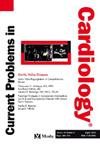完全性左束支传导阻滞患者左轴极值偏移的价值。
IF 3.3
3区 医学
Q2 CARDIAC & CARDIOVASCULAR SYSTEMS
引用次数: 0
摘要
完全性左束支阻滞(LBBB)与心血管事件风险增加相关。在LBBB的情况下,QRS轴向左极端偏差(LAD)的值是有争议的。目的:评价LBBB患者LAD(-45°)是否为收缩功能障碍和心室重构的标志。材料和方法:横断面队列研究包括102例LBBB患者,接受超声心动图评估左室(LV)直径、壁厚和射血分数(EF)。结果:平均年龄67.9±13岁。48%是女性。80.4%符合Strauss LBBB标准,28.4%有LAD。LAD组EF降低(32.2±12%比46.7±17%,p=0.00009),左室舒张末期内径指数升高(34.8±9比30.9±6,p=0.011)。LAD对EF的敏感性为45%,特异性为88%,阳性预测值为0.79,阴性预测值为0.62。LAD组心肌病的诊断频率更高(93.1%比61.6%;p=0.0016)。各组间左室肥厚发生率相似,但LAD患者偏心性左室肥厚发生率较高。结论:在LBBB中,LAD(-45°)识别收缩功能较差、左室扩张程度较大、偏心性肥厚较多的患者。此外,该人群的心肌病患病率较高。本文章由计算机程序翻译,如有差异,请以英文原文为准。
Value of extreme left axis deviation in patients with complete left bundle branch block
Introduction
Complete left bundle branch block (LBBB) is associated with increased risk of cardiovascular events. The value of extreme deviation of the QRS axis to the left (LAD) in the context of LBBB is controversial.
Objective
To evaluate whether LAD (-45°) in patients with LBBB is a marker of systolic dysfunction and ventricular remodeling.
Material and methods
Cross-sectional cohort study including 102 patients with LBBB who underwent echocardiography to assess left ventricular (LV) diameters, wall thickness and ejection fraction (EF).
Results
Mean age was 67.9 ± 13 years. 48 % were women. 80.4 % met Strauss criteria for LBBB and 28.4 % had LAD. The LAD group showed lower EF (32.2 ± 12 % vs. 46.7 ± 17 %, p = 0.00009) and higher LV end-diastolic diameter index (34.8 ± 9 vs. 30.9 ± 6, p = 0.011). LAD had 45 % sensitivity, 88 % specificity, positive predictive value of 0.79 and negative predictive value of 0.62 for identifying reduced EF. Cardiomyopathy diagnosis was more frequent in the LAD group (93.1 % vs. 61.6 %; p = 0.0016). LV hypertrophy prevalence was similar between groups, but LAD patients had higher prevalence of eccentric LV hypertrophy.
Conclusion
In LBBB, LAD (-45°) identifies patients with worse systolic function, greater degree of LV dilatation, and more eccentric hypertrophy. Additionally, cardiomyopathy prevalence was higher in this population.
求助全文
通过发布文献求助,成功后即可免费获取论文全文。
去求助
来源期刊

Current Problems in Cardiology
医学-心血管系统
CiteScore
4.80
自引率
2.40%
发文量
392
审稿时长
6 days
期刊介绍:
Under the editorial leadership of noted cardiologist Dr. Hector O. Ventura, Current Problems in Cardiology provides focused, comprehensive coverage of important clinical topics in cardiology. Each monthly issues, addresses a selected clinical problem or condition, including pathophysiology, invasive and noninvasive diagnosis, drug therapy, surgical management, and rehabilitation; or explores the clinical applications of a diagnostic modality or a particular category of drugs. Critical commentary from the distinguished editorial board accompanies each monograph, providing readers with additional insights. An extensive bibliography in each issue saves hours of library research.
 求助内容:
求助内容: 应助结果提醒方式:
应助结果提醒方式:


